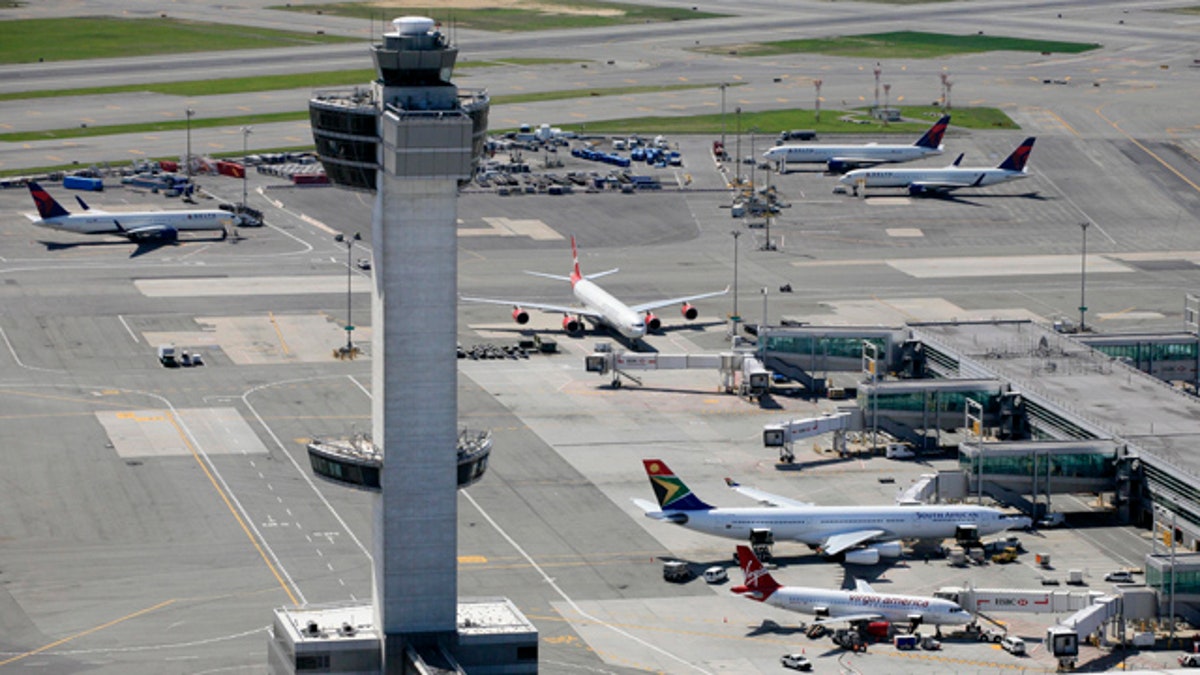
FILE: April 2010: The air traffic control tower and terminals at John F. Kennedy International Airport in New York. (AP)
WASHINGTON -- The Federal Aviation Administration announced new steps Friday to help prevent air traffic controllers from falling asleep on the job, including allowing controllers to use sick or annual leave time if they are too tired to work.
Controllers will also now be allowed to listen to the radio and read to help stay alert during overnight shifts when traffic is light under an agreement between the FAA and the National Air Traffic Controllers Association.
However, the policy changes don't include allowing controllers to take naps while on break or to schedule naps during overnight shifts even though sleep scientists say that's the most effective way to refresh tired workers.
Currently, controllers caught napping, even when on break, can be fired.
"While on break, air traffic controllers are expected to conduct themselves professionally and be available for recall at all times," the agency said in a statement.
Since April, the FAA has disclosed seven instances of controllers sleeping on the job and two other instances of controllers who didn't respond to attempts to contact them. In one case, two airliners landed at Reagan National airport in northern Virginia near Washington without assistance from a controller who has acknowledged dozing off.
In another case, FAA has said a medical flight with a seriously ill patient had to circle an airport in Reno, Nev., before landing because the lone controller on duty had fallen asleep.
Studies show most night shift workers, not just controllers, face difficulties staying awake no matter how much sleep they've had. That's especially true if they aren't active or don't have work that keeps them mentally engaged. Controllers on night shifts often work overnight in darkened rooms with frequent periods of little or no air traffic to occupy their attention -- conditions scientists say are conducive to falling asleep.
"Air traffic controllers have the responsibility to report rested and ready to work so they can safely perform their operational duties," FAA Administrator Randy Babbitt said in a statement. "But we also need to make sure we have the right policies in place to reduce the possibility of fatigue in the workplace."
John Goglia, a former National Transportation Safety Board member and a member of an FAA fatigue advisory committee, said that even with the policy changes, the agency's approach to fatigue lags far behind contemporary scientific understanding of how to prevent workers from falling sleep or becoming so tired their ability to function is eroded.
"Ironically, the information on what is an enlightened policy on fatigue resides within the FAA in all the (research) they've done over the years on fatigue," Goglia said.
After disclosure of the first few sleeping incidents, FAA officials adjusted controllers' work schedules to provide a minimum of nine hours off between shifts, an increase of an hour.
However, the agreement between the agency and the union puts off decisions on what to do about work schedules that have been criticized as especially fatigue-inducing. One common weekly schedule is called "the rattler" by controllers because it turns around and bites those who work it. But it's popular with some controllers because it effectively creates a three-day weekend.
Instead, the agency and the controllers association said they are also working on developing new work schedule "principles" aimed at reducing fatigue. They said those principles will be ready in 14 months if not sooner. And, they said, new work schedules are already being put in place in some air traffic facilities.
The FAA said it has also agreed to develop policies to encourage controllers to seek medical help for sleep apnea, a disorder that causes abnormal pauses in breathing and often prevents restful sleep. Currently, controllers diagnosed with sleep apnea aren't permitted to continue to work.
The agency said it will work to develop a process for most air traffic controllers with sleep apnea to regain their medical qualification after receiving medical treatment.
Under the agreement, the FAA is also developing a system to collect and analyze data associated with work schedules, including work intensity, to ensure that the schedules are not increasing the possibility of fatigue. Such "fatigue management" systems are commonly used in other areas of aviation, including flight crew schedules.




